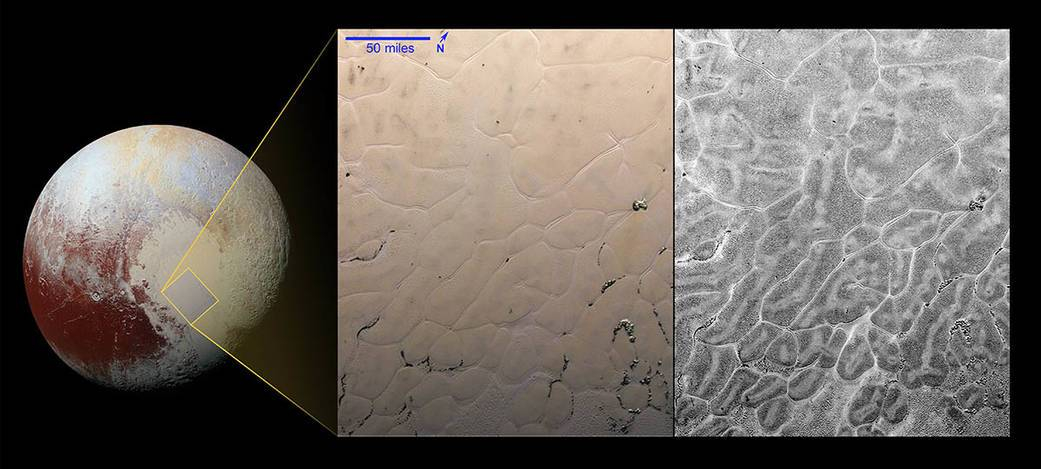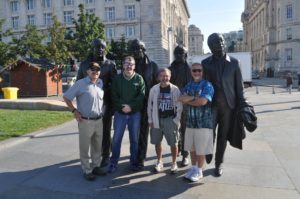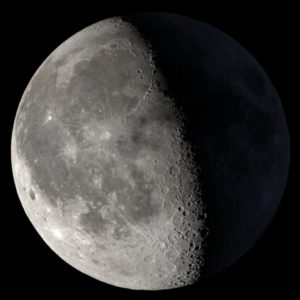(cover photo above: Pluto surface detail from New Horizons space probe, 2016)
BOSTON — In the city that helped launch the great democracy experiment known as America, scientists from around the world gathered last month to discuss and share their latest research — and to draw battle lines against the ideological, anti-science platform of the new administration in Washington.
The scientific community here and abroad faces a Republican-led Congress and White House that, among many anti-science initiatives, seeds doubt against the lifesaving success of vaccines and denies the science behind climate change. As they gathered at the annual meeting of the American Association for the Advancement of Science, they issued an urgent warning: basic science matters. Leadership of the international organization also called upon its members to advocate publicly for the importance of science in our everyday lives.
In her opening address, AAAS President Barbara Schaal left no doubt about the need to counter a movement that threatens to set back centuries of advancements pioneered by scientists from Isaac Newton to Albert Einstein.
“The case for science must be made again and again so that government understands the essential, critical role science plays in our lives,” said Schaal, also dean of the faculty of arts and sciences at Washington University in St. Louis.
“Sadly, in the U.S. over the last 10 years, there’s a feeling of concern that the entire scientific enterprise is under threat, that our position in the world is eroding, and that we’re marginalized,” she added. “Our concern is that science is being discounted as just another policy system. We’re concerned with intensifying hostility toward science in many parts of globe. We need the entire science community to have a clear voice and deliver a message for science.”
Schaal said she is particularly concerned about lack of support for what she calls “basic science.” That’s more fundamental science conducted without specific applications or products in mind. The results of these endeavors form the foundation for eventual breakthroughs that benefit all of us — but they are misunderstood because it often takes decades for that type of research to pay off.
I had the opportunity to report on the four-day meeting for the newspaper where I began my career: The Springfield Republican, known as The Springfield Daily News when I worked there from 1981-83. In my first story, I summarized Dr. Schaal’s speech. I know most scientists resist the urge to leave the realm of evidence-based science discuss politics, so I was impressed with Schaal’s strong words — some of which even targeted the Oval Office occupant.
Reporting on the meeting
AAAS’ annual conference, the 183rd meeting for the group, featured hundreds of sessions during which scientists presented some of their latest work. I wrote about three of them for the Springfield newspaper.
The first story involved a West Virginia University professor leading an effort to develop a portable approach to positron emission tomography, also known as PET scans. Today, PET scanners are large, immobile devices in which patients must sit or lie down. But scientists like Julie Brefczynski-Lewis see the need to study brain processes while a patient is performing an activity, like walking. This could pave the way for better understanding of the brain and possibly unlock secrets to cures for Parkinson’s disease and other maladies.

West Virginia University’s Julie Brefczynski-Lewis and a mockup of her portable PET scanner
Other scientists are working to transform basic components of smartphones, such as the microphone, into portable diagnostic devices. In the future, asthma or chronic obstructive pulmonary disease patients could simply blow into the speaker and obtain instant feedback about their breathing. If Professor Shwetak Patel and his colleagues at the University of Washington have their way, our smartphones could help us detect a range of illnesses or track existing ones.
Because I’ve always been fascinated with the science of space travel, one of my favorite sessions and stories I wrote involved legendary planetary scientist Alan Stern and his work on the multi-year New Horizons space probe mission to Pluto. Stern is one of the leading space scientists of our era, and he’s articulate. No wonder Time Magazine named him one of the 100 most influential people of 2016.
That’s also why I couldn’t resist having a photo taken with him after his talk:

At the beginning of his presentation, Stern showed one of the best images of Pluto in existence before New Horizons was launched in 2006. Taken from telescopes on Earth, it was not a very sharp picture:

And then New Horizons started sending back gems like this last year, as well as the cover photo above:

New Horizons’ work is not done. After passing Pluto, the tiny atomic-fueled probe is continuing on to examine other objects in the outer edge of our Solar System, also known as the Kuiper Belt.
There was a lot more science presented at the AAAS meeting, and I did write about a few more. I’ll share them on my blog in the near future.
But I left there feeling the scientific community has awakened to the need to better express the value and importance of their work — in a world that has become more polarized and often dismissive of evidence-based science.




